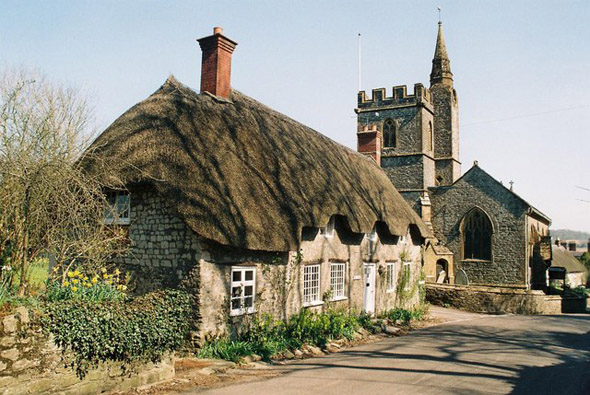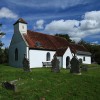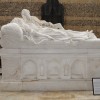Evershot
Evershot
More than Just a Village
Evershot is a large village nestling in a valley of chalk and Greensand in the north-west portion of Dorset, well-sheltered by blocks of beech woodland. It is situated between Beaminster and Cerne Abbas, being about 7.5 miles north-east of the former, and anciently came under the Saxon Hundred of Tollerford, now part of the diocese of Salisbury.
This village has other claims to fame. At 90 metres (625 feet) Evershot is the second highest in the county (Ashmore is the first), and is also the parish in which the River Frome has its source. The source of a tributary stream of that river, known locally as St John’s Spring, also rises within the parish, and there are the Evershot Stones (or The Three Dumb Sisters) – a group of close-standing megaliths now doubling as a public bench. A legend states that they were once three girls turned to stone for dancing on the Sabbath.
Though Evershot can accurately be described as a large village it has also been referred to by one authority as a large town. It has also been said of Evershot that “..it is a neat, clean little place with nothing worthy of notice”. Certainly in bygone days the population was considerably larger, as this included the resident yeomen farmers and tradesmen of the village and their families. Yet today the in-living population barely reaches 200, a figure that includes children, though not the hotel workers who commute in to keep the village’s vibrant tourist trade ticking over.
Tracing Evershot back to its earliest antiquity and writing a comprehensive organised history of this village has been described by one authority as an undertaking which could take years of full time research. The Dumb Sisters, a Bronze Age monument, indicate some prehistoric habitation in the parish, but otherwise Evershot can hardly be traced back further than the 12th century, when traces of Norman stonework preserved in the church were first laid.
The parish church, dedicated to St Osmund, was originally a “chapel of ease” for Frome St Quintin, though the living is now independent of the parish. In 1853 a restoration of all but the tower and chancel was carried out in Forest Marble with Ham Stone for the dressings. The style replicates early 15th century Gothic with a nave of three bays, aisles, and a south porch. The south-east corner of the tower is produced into a short spire in which a small clock face has been set. There is a peal of six bells. St Osmund’s living is a chapelry annexed, with Melbury Bubb’s rectory, to that of Frome St Quintin. The church also holds 1.25 acres of Glebe land; the parish registers start from 1694.
Some of these original St Osmund parish records of births, marriages and burials still reside in the church safe. The earliest record is of the marriage of William Groves and Sarah Gale in 1707. A descendant of William, Richard Groves, lies with his wife Elizabeth in the churchyard, their grave marked by a prominent headstone.
The local manorial estate is Melbury House & Park, home of the Strangeways family, Earls of Ilchester. The main thoroughfare, Fore Street, transects the village from east to west in a single broad arc, with side roads and lanes, most notably Summers Lane (to Cattistock) and Tanyard, off from the south. Along these streets stand a mixture of buildings ranging from 16th century through Edwardian to modern; built of stone, plaster or unadorned brick; roofed with thatch or slate. Today a doctors surgery, post office/shop, primary school, bakery, inn, hotel, and some light industry comprise the socio-economic mix of life in the village. Near to and opposite the church there are some Edwardian-style houses with bay windows and laid to lawns in the front. Beyond the church is Tess Cottage. The post office-cum-stores occupy a building with a quaint double-bay frontage.
Evershot’s principal pub-restaurant on the high street is The Acorn Inn, once also known as The Kings Arms, a traditional 16th century coaching inn which appears as “The Sow & Acorn” in Thomas Hardy’s Tess of the D’Urbervilles. This inn once brewed its own ales using water drawn from the Frome. Today the accommodation features nine on-suite bedrooms (each named after a Tess character), two oak-panelled bars, and a skittle alley-cum-function room for 60 people.
After the Church and Inn, the next institution to be established at Evershot came in 1628 when Christopher Stickland founded a Free School for “reading, writing, grammar, and the instruction and breeding of men and children”. A market was once held in the village on Saturday, but has been discontinued for many years; a fair for cattle, pigs and cloth was formerly held on May 12th. The Mummery play was also once regularly performed here at Christmas.
Evershot is one village which appears to be well-documented regarding its former male residents. The Dorset History Centre retains a hand-written notebook containing a record known as a Militia List, which notes the names and occupations of 74 of the village’s men between the ages of 18 to 50, eligible to serve in the county Yeomanry near the time of the Napoleonic Wars. The 1831 census revealed that there were living in the village: 12 cordwainers (leather boot makers); 23 labourers, 4 yeomen; 3 tanners; 3 woolcombers; 3 barbers; 2 wool staplers; 2 butchers; 2 clerks, 2 tilers; 2 plumbers, 2 thatchers, 2 hoopers (barrel makers) and one of each other occupation. Ploughmen, innkeepers, servants and shepherds, however, do not appear in Evershot’s list. For the 1841 census a population of 566 was recorded.
On the 26th of September 1865 a serious fire destroyed about 18 homes, mainly in Summers Lane, which was discovered at the home of the village’s carpenter at 1pm. Only one or two cottages survived the fire, though no lives were lost (for a full account of this tragedy see Fire at Evershot – 18 Houses Destroyed, 100 Homeless in the Evershot category). At the time of the 1871 census it emerged that there were three women blacksmiths working in Evershot!
There are some good hotels in the parish, of which the Summer Lodge Hotel must rank first, having a chequered history including a bevy of fascinating facts. Now a grade-listed building, the hotel began life as a dower house built by the 2nd Earl of Ilchester in 1798. Another two floors were added in 1893, to plans drawn up by Thomas Hardy (when still working as an architect) and a further modernisation was carried out by Lord Stavordale – the last earl to live in Dorset – in 1932. It was then vacated and lay derelict for three years from 1976 to 1979, when Nigel and Margaret Corbett bought the hotel, converting the stables and coach house into more bedrooms in 1988. Summer Lodge then came under new ownership and management in 2003, but before 2000 the property had been in the possession of only two families throughout two centuries.
In 1918 Evershot Womens Institute was founded. The Parish Council began building the village hall in 1919, though the WI could not hold its first venued meeting there until the hall was completed in 1921. When war was declared in 1939 the women were forced to meet in member’s homes after the hall was commandeered by the army. In 1996 an over 60’s Club was formed, meeting in the village bar on the third Thursday of each month (interestingly, a scene or scenes for Jane Austen’s Emma was filmed in Evershot in the same year).
As Evershot is quite small with a small population sports events are infrequent, though well-supported. The football and cricket teams meet at the Acorn Inn and play two matches a year on bank holiday weekends. The football team plays against Cattistock Fox & Hounds; the cricket team plays against the team from the Fox Inn at Corscombe. Although 16 organisations were recorded in the village in 1975, by 2002 only the Parish Council, Parochial Church Council, Playgroup and Stickland’s School were still functioning. For local transport the Weymouth branch of the Great Western Railway was routed near the border of the parish, with a station being built at Holywell, about 1.5 miles east of the church; there are bus services to Weymouth, Dorchester and Yeovil.
In 2000 the Parish Council balloted villagers for suggestions on how to best mark the Millennium. After the votes were cast about twelve project ideas were short listed, but the outright winner was an ambitious scheme to make the source of the Frome attractive to Evershot’s visitors. The work towards the project included clearing the river bank of scrub after coming to an agreement with Ilchester Estates, who own the land at the Frome’s source. The Parish Council agreed to pay an annual sum towards the maintenance of the amenity.
My Brief Wartime Escape to Dorset
It was the autumn of 1943, the blitz over London and its suburbs was intensifying when my parents decided it was time to find somewhere a little safer for us. When I say us, I mean myself a lad of 7 years, and my baby sister who at that time was around 9 months.
We lived in a little end of terrace house in Norbury, South London and every night we were obliged to scramble into our air raid shelter for protection, but the introduction of Germany’s ‘flying bombs’ meant that our safety could no longer be guaranteed. My Mother’s brother and sister had already made the move to Dorset with my cousins, and it was therefore quite natural that she should write to them to see if any accommodation could also be found for us.
It was not long before my mother, myself and younger sister found ourselves in the village of Leigh. How we travelled there, I cannot remember, but we were evidently expected and were taken to stay at the vicarage in the centre of the village. Reverend and Mrs Back made us welcome and gave us a large downstairs room at the rear of the property as our ‘bed-sit’ for as long as we needed it.
The vicarage was reached by a drive from the main village street and the local school was situated to one side of the gateway. Village life was strange for me, and I didn’t make friends or see much of the local children outside of school. The school was very small by comparison with the one I had left behind and consisted of only two classes. As a Londoner, I was treated with suspicion and it took me some while to get used to the mixed ages of my classmates, and the fact that our teacher taught us on every subject.
It was my role, every morning before school to walk down the vicarage drive to the farm which lay on the opposite side of the road on the corner of the road leading to Yetminster. I took a milk can with me and this was filled up with fresh cows milk by one of the two ‘foreign’ men who were working there. I subsequently learned that they were Italian and although resident in this country at the start of the war they had been taken into custody and then assigned to work on the farm at Leigh. I still remember their funny accents as both they and I grappled with payment for this daily milk supply. My mother used to take us out for walks at the weekend, and we walked for miles all around the local lanes and when necessary as far as Yetminster where they had a few more shops.
Staying in the vicarage, we felt obliged, of course, to attend the parish church services. The church was a little way along the village street and then down a side turning. The services were strange to me and I soon became bored. On the other hand, my uncle who was living in the nearby village of Evershot was a Methodist lay preacher and would come over to Leigh every few weeks to take a service in a little chapel. I looked forward to those times as it was good to see someone who I knew and also I would more easily follow the service.
It was after the finish of one of my uncles evening services that there was great excitement. On coming out of the chapel we were greeted by smoke and it was soon obvious that the thatched roof of one of the cottages was on fire. The cottage was opposite the chapel and backed onto the grounds of the vicarage. After returning to the vicarage I was permitted to go and stand in the garden and watch the firemen at work. The old thatch had, for economic reasons, been covered with corrugated iron sheets and the firemen had to get these off before they could hose the burning straw. Sadly they were unable to prevent the fire spreading throughout the cottage and come next morning only the walls were left standing. I remember the stench of burnt wood and straw was around for days and I still clearly remember the lady and her family who occupied the cottage throwing their belongings out of the windows into the garden in a desperate attempt to save as much as possible.
My mother found it very difficult living in the confined space of the bed sitting room and eventually arranged for a sort of holiday for us in Evershot. We walked with my sister’s pram to a little railway station called Chetnole Halt, where we boarded a Great Western Diesel Railcar painted chocolate brown and cream, and travelled to the next stop which was another little halt at Holywell. This no longer exists. We then walked some distance over East Hill into Evershot. We were put up by a lovely lady who lived in Summer Lane opposite the farm on the corner of The Common. Her name was, I believe, Mrs Gilham and she lived there with her son who must have been in his teens at the time.
Although I only stayed at Evershot for two weeks and visited the village on perhaps only two or three other occasions, I remember more about it than Leigh where we stayed for several months. Having my cousins already living there meant that I was soon caught up with village life and they made sure I was not left out of their activities. As our break was during normal school term time they were all at school during the day, but I remember waiting for them at the school gates and then going off with them to explore the countryside around the village.
My uncle was working on the local Melbury estate and lived in a lodge with his family. I remember visiting them and seeing all the good things that my uncle was helping to grow. My Aunt from the other family, together with my cousin David were living in a cottage in Fore Street that was the home of the local bus driver. Whether or not he owned the bus I do not know but he regularly ran a one man service to the towns of Dorchester, Yeovil and Sherborne. I never got a chance to go on this bus, and I was very envious of cousin David who was allowed to go with him, and was given the task of issuing the tickets to the passengers as they boarded the bus.
Mrs Gilham made us very welcome, and the cottage was very cosy. Her son, who name now escapes me, often played a game of ‘lotto’ with me which I thoroughly enjoyed. Lotto, of course, subsequently evolved in ‘Bingo.’ We never played for money but just for our own amusement, and as a seven-year-old with time on his hands any thing like that was very welcome. I also remember the pictures on the wall of the cottage which I found fascinating and was forever asking questions about them.
Sundays in Evershot were different. We all went to a little chapel where I found the services much easier to follow. To be able to sit with my cousins and just enjoy their company seemed to make this strange existence much easier to bear.
I recently returned to both Evershot and Leigh for the first time in 63 years. I was surprised to find that I did not recognise much of Leigh. It did not help to find that the vicarage has now become a nursing home, the old school along side the drive to what is now a nursing home has been turned into housing, and the farm to which I trotted each morning to collect milk is now derelict. Sadly, I did not recognise any other building or road in the village; so much had changed in the intervening years.
Evershot was different. As I drove down Fore Street I immediately recognised the row of cottages where my cousin had lodged with the bus driver, although I must admit to having totally forgotten the raised footpath all alongside one side of the road. It was also strange to see the road full of parked cars. To see private cars in those rural locations during the war years was very rare and I think we used to walk along the roads as there was just never any traffic.
Then reaching the junction with Summer Lane I immediately recognised the turning and especially Mrs Gilham’s cottage. I did not attempt to find out who lives there now or to ascertain whether her son is still around. I just took some photographs to remind me and then drove away leaving those memories behind me.
As my wife and I drove on to our home in Sussex we marvelled at how far my mother and I used to walk in those days and how much we enjoyed the countryside. It is a different story now with so many vehicles travelling along those once quiet byways that it is just not the same.
Fire at Evershot
18 Houses Destroyed – Over 100 Homeless
On Tuesday 26th September 1865 at Evershot a fire destroyed eighteen houses, the property of the Earl of Ilchester, making more than one hundred people homeless. The houses were in Summers Lane and the main street: the residents living in Summers Lane lost nearly all their possessions the people on the main street were more fortunate having time to salvage some of the contents of their homes before the fire took them. The wind carried the flames and sparks across the narrow road on to a barn and slaughterhouse occupied by Mr. Trenchard a butcher.
Reporters from ‘The Western Gazette’ and ‘The Western Flying Post’ ascertained from enquiries on the spot that the fire was started by hot ashes being placed in a back house connected to the premises occupied by Mr. English, a carpenter. The flames were discovered about one o’clock in the afternoon “the whole house being almost instantly enveloped in flames.” The neighbouring houses with their thatched roofs as dry as tinder, the result of a long drought, it was clear that the whole of the lower end of the town was in danger of being engulfed in the fire.
Police Constable Hare was on the scene almost immediately and despatched messengers for the two fire engines kept at Melbury House. Telegraphic messages were sent to Yeovil for more fire engines and to Dorchester for police officers. ‘The Western Gazette’ reported “ The request for the engines reached Mr. Bradley, the Captain of the Yeovil Volunteer Fire Brigade, at a quarter past two, and his engine started in fifteen minutes after its receipt, and reached Evershot in 45 minutes” drawn by four of Mrs. Bulleu’s best horses. Before its arrival a change in wind direction had driven the flames across the main street and “house after house fell victim to the flames” making both the main street and Summers Lane impassable.
The heat was so great that it was impossible to approach any of the burning premises. ‘The Western Gazette’ reporting “It seemed probable that the fire would sweep up both sides of the street, and wipe Evershot out altogether. It was only by dint of the most strenuous and well-directed exertions of those in charge of one of the Melbury House engines, and of the Yeovil Brigade engine, that this catastrophe was averted, and the fire confined to the lower end of the village.”
It being agreed that attempting to extinguish the fire in the houses where it was already raging was useless all the efforts of the firemen were directed to cutting off the flames and preventing the fire spreading down the street. Fortunately there was an abundant supply of water in a stream only a hundred yards or so away. By keeping the houses next to those which were burning completely saturated with water, the firemen finally got control and saved the rest of the village.
The names of the families of those persons made homeless: Charles White, labourer; George Brett, tailor; E. Rutley, labourer; T. Frampton, labourer; A English, carpenter; S. Christopher, butcher; W. Groves, labourer; J. Groves, shepherd; J. Childs, labourer; J. English, labourer; J. Tompkins, labourer; J. Groves, gamekeeper; A Sartin, widow; J. Perrett, cooper; S.Chubb, shopkeeper; J. Edwards, bootmaker; E Knell, tailor; S. Jessop, labourer and Mr Trenchard, butcher, lost his barn and slaughterhouse.
The buildings were uninsured presenting the Earl of Ilchester with a substantial loss. Mr Chubb’s stock and furniture were insured but his loss still amounted to £100. The local newspapers reported “A body of police soon arrived from Dorchester; and under Supt. Brown, who happened to be in the village, and Sergeant Vickery, they rendered valuable assistance.” No life was lost nor was anyone injured.
Those reporting the event were quick to comment on the way the community all pulled together regardless “to class or station.” Singled out by the Press for particular praise were the following individuals:Mr. Baskett, solicitor; Mr.Martin; Mr Baring, the Earl of Ilchester’s steward; the Rev.Greenhill, Mr Clapcott and Mr.Forward; and the Rev. Collins, the clergyman of the parish, and his wife and daughters, were seen handing to each other the buckets of water for the engines. Mr. Clapcott, Mr.Collins Mr.Martin and others, opened their houses and provided refreshments for all that needed them.
The following week the local press was still following the story but by now it was the darker side of human nature they had to write about. “Blankets and bedroom carpets, which had been saved from the fire disappeared most mysteriously, and the contents of a butt of cider, the property of Mr. S. Christopher, which had been removed to Mr Knell’s garden for safety, were likewise stolen” ‘The Western Gazette’ continued “ We trust that the heartless wretches who took advantage of this great calamity to rob their neighbours may be speedily brought to justice.”
By early morning on the Sunday following the disaster it was reported that from 600 to 1,000 people, the inhabitants of the neighbouring towns and villages, had come to see the scene of the fire. In the evening the church was crowded and many strangers were present. The Rev. E. Collins selected his text from the first verse of Proverbs chapter 27.“For thou knowest not what a day may bring forth.”




